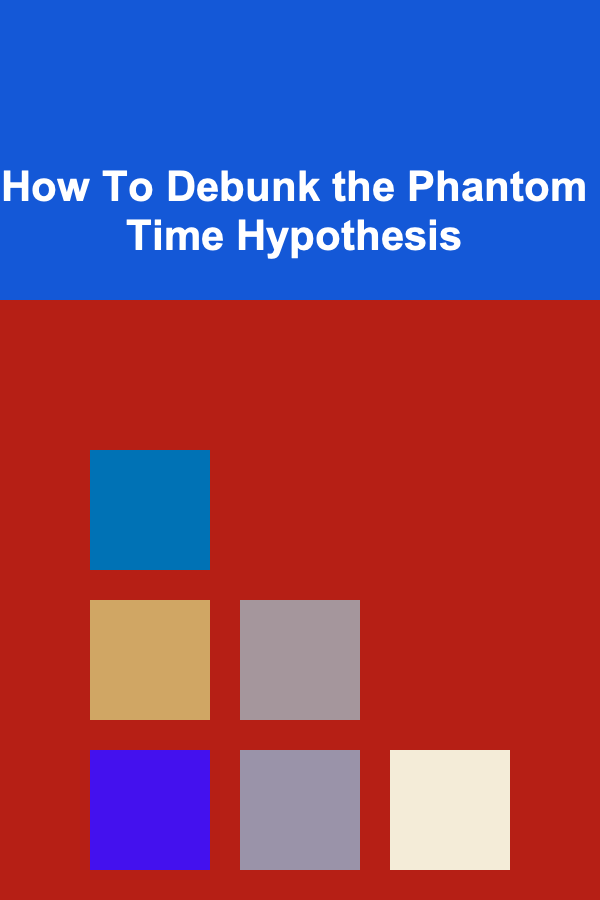
How To Debunk the Phantom Time Hypothesis
ebook include PDF & Audio bundle (Micro Guide)
$12.99$8.99
Limited Time Offer! Order within the next:

The Phantom Time Hypothesis (PTH) is a theory that posits a large chunk of history, roughly 297 years, was fabricated or erroneously recorded by historians and chroniclers. The theory suggests that the years between 614 AD and 911 AD, or what we generally consider the Early Middle Ages, may not have existed in the way we think, and instead, those years were an invention or mistake of historical records. This hypothesis was proposed by German historian Heribert Illig in the 1990s and has sparked significant debate.
Although the Phantom Time Hypothesis is considered a fringe theory, it raises questions about how history is recorded, interpreted, and manipulated. It plays on the idea of historical skepticism, challenging us to reconsider the veracity of the sources we take for granted.
In this article, we will explore the various arguments that have been used to support the Phantom Time Hypothesis and then systematically debunk them with evidence from historical, astronomical, and archaeological perspectives.
The Foundations of the Phantom Time Hypothesis
The Phantom Time Hypothesis was first presented by Heribert Illig in his 1996 book "The Invention of the Middle Ages". Illig argues that a period of about 297 years, from 614 AD to 911 AD, was either invented or inaccurately recorded, and that the present year is actually around 1726 AD rather than 2025 AD.
The core argument of the hypothesis is built upon a few key claims:
- Calendar Irregularities: Illig suggests that the Gregorian calendar, which was introduced by Pope Gregory XIII in 1582, was altered to account for the missing time. He believed that discrepancies in the historical timeline arose due to faulty calculations or deliberate tampering.
- Lack of Archaeological Evidence: The PTH proponents argue that archaeological evidence for the years between 614 and 911 AD is insufficient or non-existent, suggesting that the historical events that we attribute to this time may have been fabricated.
- Astronomical Issues: Illig's hypothesis also hinges on the claim that astronomical data from this time period is inconsistent with the accepted historical timeline, particularly concerning solar and lunar eclipses.
The Primary Proponent: Heribert Illig
Heribert Illig, a historian and archaeologist, gained attention for this theory in the 1990s. While Illig's work was met with skepticism by the academic community, the Phantom Time Hypothesis still found traction among a segment of the public interested in alternative history theories. His work focused on errors in the dating of ancient events and questioned the veracity of historical documents.
The PTH became especially controversial in the years following its publication, as it challenged not only the understanding of history but also the methods used to record it. Illig's ideas prompted others to question the traditional views of chronology and sparked a renewed interest in how we determine the timeline of human history.
Key Points of the Phantom Time Hypothesis
- The 10th Century Reinterpretation: Illig suggests that the 10th century may have been a fabrication. Historical events attributed to the time period, such as the reign of Charlemagne, could be entirely fabricated or misdated.
- Roman Empire Survival: The theory also proposes that the collapse of the Roman Empire may have occurred later than traditionally thought, and that the early Middle Ages might have been exaggerated in historical texts.
- The Absence of Archaeological Evidence: One of the strongest claims put forward by proponents of the Phantom Time Hypothesis is the lack of significant archaeological evidence from the 7th to 10th centuries. However, this claim has been strongly contested.
The Appeal of the Phantom Time Hypothesis
The Phantom Time Hypothesis taps into the curiosity that many people have about the accuracy of history and the possible manipulation of historical narratives. In an era where history is written largely by the victors, it's understandable why this hypothesis appeals to those who seek alternative explanations for the world around them. However, in the pursuit of understanding, it is essential to confront the claims of the hypothesis with scrutiny and evidence-based analysis.
Debunking the Phantom Time Hypothesis
Now that we have established the foundation of the Phantom Time Hypothesis, it's time to look at the arguments against it. A critical examination of the PTH reveals significant flaws in Illig's reasoning and his interpretations of historical and scientific data. The following are key reasons why the Phantom Time Hypothesis is not supported by mainstream scholars:
1. Astronomical Evidence Contradicts the Hypothesis
One of the strongest counterarguments against the Phantom Time Hypothesis comes from the realm of astronomy. The theory argues that astronomical data from the supposed "missing" years doesn't match up with the historical timeline. However, this claim fails when subjected to rigorous examination.
Solar and Lunar Eclipses
Illig claims that astronomical data from the early Middle Ages---particularly lunar and solar eclipses---do not align with the historical timeline. However, experts in the field of astronomy and historical chronology have thoroughly examined this claim and found it to be inaccurate. Ancient astronomers, like Ptolemy, made highly accurate observations that have been preserved through various ancient texts, and these records corroborate the existence of eclipses at specific times during the "missing" years. The precise prediction of solar and lunar eclipses can be traced to ancient records, which provide solid evidence that the timeline of history is correct.
In addition, modern astronomical software can simulate the positions of celestial bodies across time with extreme accuracy. When experts use these tools to calculate the positions of the sun, moon, and planets during the supposed "phantom" years, they find that the data aligns with the accepted historical record. This contradicts Illig's claim of astronomical anomalies.
The Gregorian Calendar
The Phantom Time Hypothesis also hinges on the idea that the Gregorian calendar was created to mask a fabricated period of history. However, the Gregorian calendar, which replaced the Julian calendar, was introduced precisely to correct a known problem with the calendar's accuracy. The Julian calendar was too long by about 11 minutes per year, which caused a slow drift in the dates of key events in the Christian calendar. The Gregorian reform adjusted for this by dropping 10 days from the calendar in 1582, which was a necessary correction and not part of an effort to create a false historical record.
2. Archaeological Evidence Contradicts the Hypothesis
Another central argument made by proponents of the Phantom Time Hypothesis is the supposed lack of archaeological evidence from the 7th to 10th centuries. Illig claims that the archaeological record from this time period is sparse or non-existent, suggesting that this period may not have existed.
Historical Artifacts and Monuments
This claim is misleading. Archaeological excavations and historical artifacts from this era have been uncovered in vast quantities. Evidence from the Carolingian period, such as manuscripts, coins, and religious structures, points to a vibrant and significant period of history. Charlemagne's reign, often cited by proponents of the PTH, is supported by a rich archaeological record, including coins, buildings, and texts from that era.
Additionally, excavations at various sites in Europe and the Middle East provide ample evidence of settlements, trade, and cultural exchanges during the supposed "missing" centuries. These findings directly contradict the notion that this time period was entirely fabricated.
The Role of the Islamic Golden Age
The Islamic Golden Age, which overlaps with the period of the alleged "phantom time," provides another strong rebuttal to the hypothesis. During this period, the Islamic world made significant advancements in science, mathematics, medicine, and philosophy. Historical records from Islamic scholars, including astronomical observations, philosophical treatises, and medical texts, provide concrete evidence that this period existed and contributed greatly to the development of global knowledge. The cultural exchange between the Islamic world and Europe during this time is well-documented and cannot be dismissed as part of a fabricated history.
3. The Persistence of Written Records and Chronicles
Illig's claim that the historical records of the 7th to 10th centuries are unreliable or fabricated is undermined by the sheer volume of written records from this time period. The medieval period was one of significant literacy, especially among clerics, monks, and scholars, who kept detailed annals and chronicles. These records were meticulously preserved, often in monasteries or libraries, and have been studied extensively by historians.
Monastic chronicles, such as the Annals of Fulda, provide a continuous and reliable account of events during the so-called "missing" centuries. These texts were written contemporaneously or shortly after the events they describe, making them trustworthy sources of historical information. Even if some of these texts contain errors or exaggerations, they are still valuable historical documents that provide a framework for understanding this period.
4. Carbon Dating and Archaeological Methods
Carbon dating and other modern archaeological methods offer another powerful tool for debunking the Phantom Time Hypothesis. These scientific techniques allow historians and archaeologists to date artifacts, bones, and other organic material with great precision. Radiocarbon dating, in particular, has been used to date artifacts from the 7th to 10th centuries, providing evidence that these periods existed.
In addition, dendrochronology (tree-ring dating) has been used to establish precise dates for wooden artifacts from this period. These scientific methods leave little room for doubt about the existence of these centuries, as they offer independent verification of historical timelines.
Conclusion
The Phantom Time Hypothesis, while intriguing in its challenge to conventional history, is not supported by credible evidence from a wide range of disciplines. The astronomical, archaeological, written, and scientific evidence all points to the fact that the years between 614 AD and 911 AD did indeed occur, and the historical events attributed to this period are well-documented and verifiable.
In debunking the Phantom Time Hypothesis, we reaffirm the importance of evidence-based historical inquiry. The methods used to study history---ranging from careful analysis of astronomical data to the application of scientific dating techniques---allow us to construct a reliable and accurate timeline of human history. While it's natural to question and scrutinize the past, it's equally important to rely on rigorous methods to uncover the truth, rather than giving credence to speculative theories that lack solid evidence.
Ultimately, history is not a fixed narrative; it is a complex tapestry woven from countless sources of evidence. However, the Phantom Time Hypothesis remains firmly in the realm of fringe theories, with little to no credible support from mainstream historians and scientists.

How to Create a Budget for Home Decor on a Small Income
Read More
How to Make Money Online as a Game Developer: 10 Actionable Ideas
Read More
How to Sell Homemade Preserves on Etsy: A Comprehensive Guide
Read More
How to Sell Vintage Furniture on Facebook Marketplace: A Comprehensive Guide
Read More
How To Create Fuller-Looking Lips Instantly
Read More
How to Understand Your Rights as a Consumer
Read MoreOther Products

How to Create a Budget for Home Decor on a Small Income
Read More
How to Make Money Online as a Game Developer: 10 Actionable Ideas
Read More
How to Sell Homemade Preserves on Etsy: A Comprehensive Guide
Read More
How to Sell Vintage Furniture on Facebook Marketplace: A Comprehensive Guide
Read More
How To Create Fuller-Looking Lips Instantly
Read More